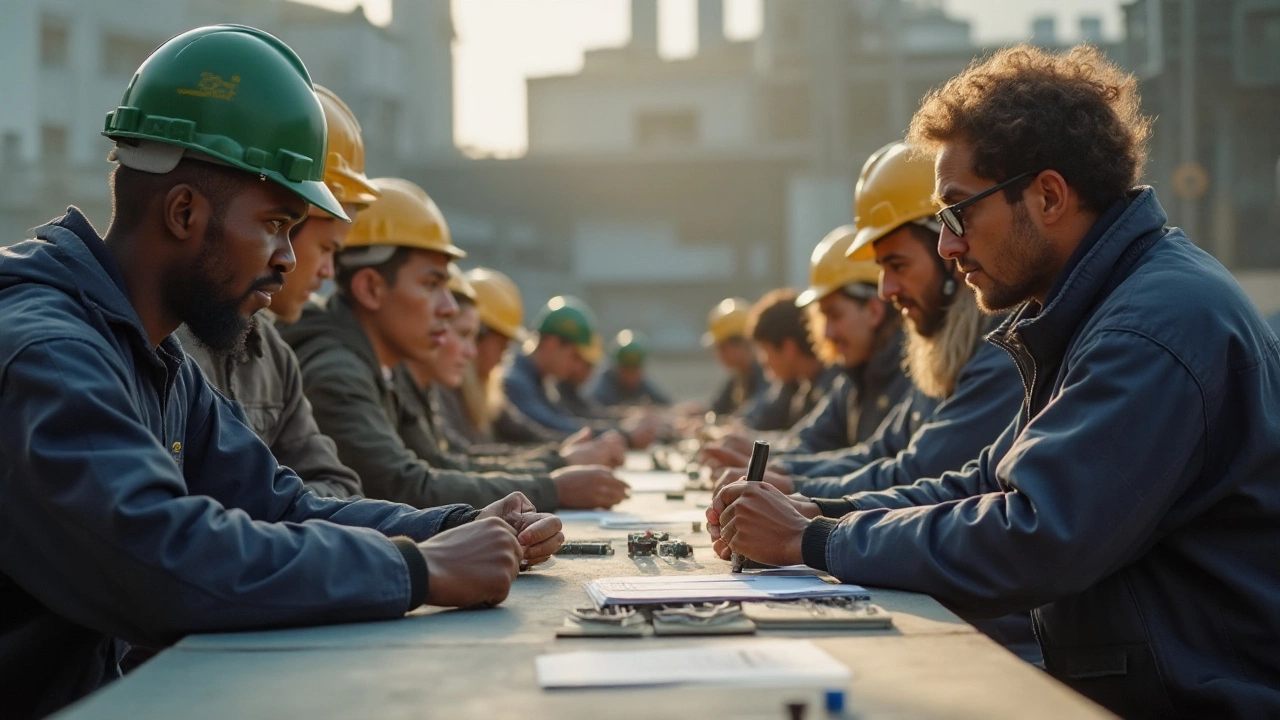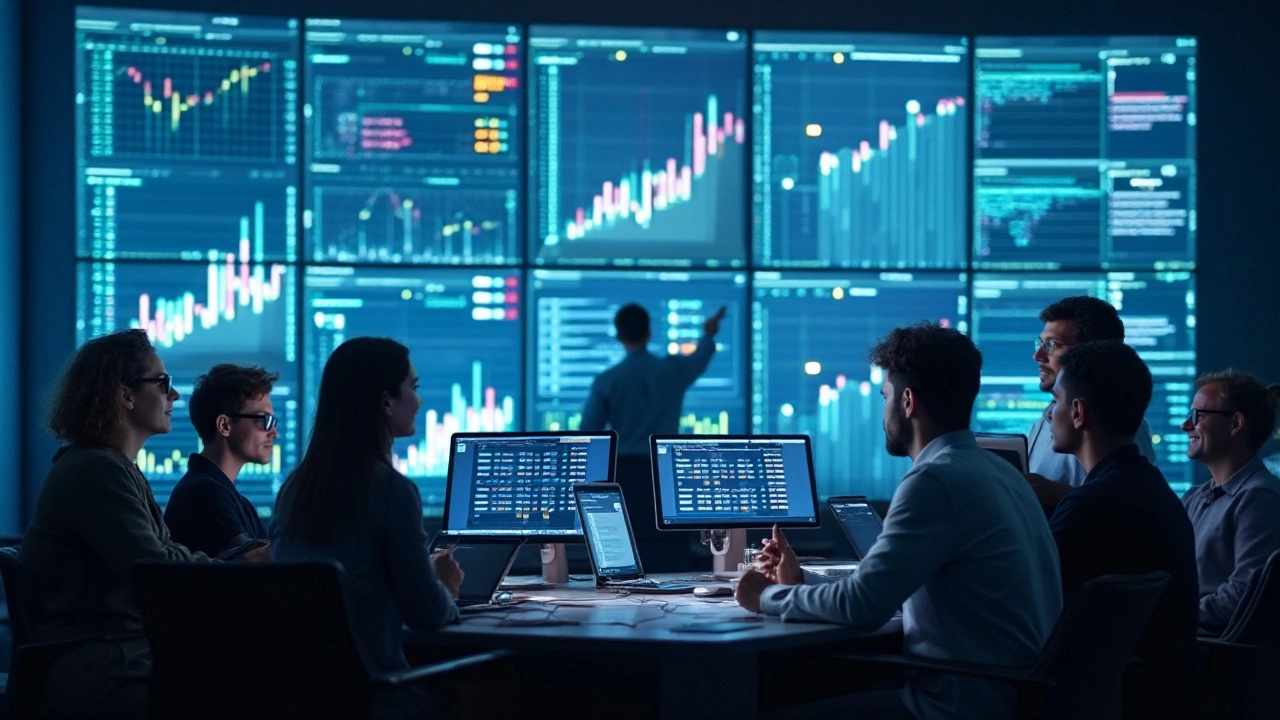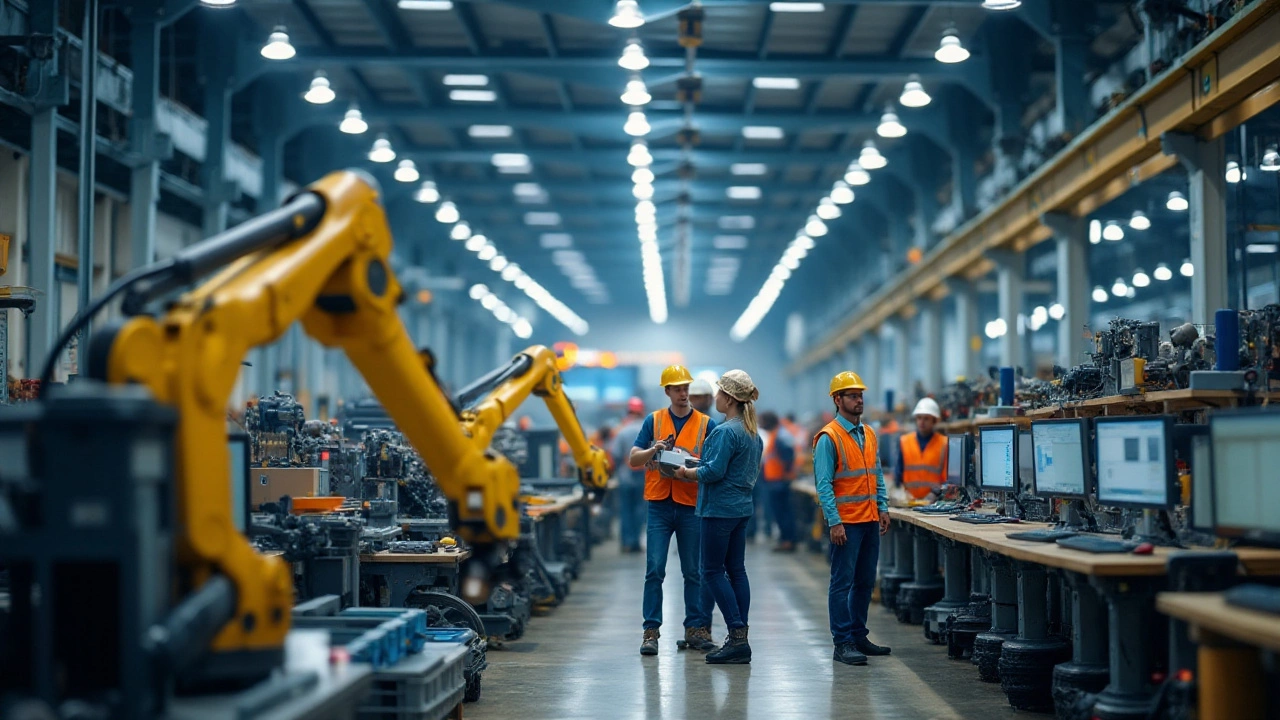In recent years, America finds itself at a crossroads in its industrial journey. The landscape of manufacturing is changing rapidly, sparking a debate on whether the country is deindustrializing or merely evolving. Once labeled as the bustling heart of industrial activity, the U.S. now grapples with the realities of a transforming global economy.
Jobs which once fueled entire communities are now being swept away by technological advancements and offshoring. Yet, it’s not all doom and gloom. With strategic government policies and innovations, there is potential for revitalization. As we delve deeper, we uncover not just the challenges but also the opportunities that lie ahead for American manufacturing.
- Understanding Deindustrialization
- The Current State of American Manufacturing
- Government Initiatives and Policies
- Impact of Global Competitors
- Future Outlook for U.S. Industry
Understanding Deindustrialization
Deindustrialization typically refers to the transformation that takes place when a nation experiences a decline in its industrial activity, specifically in manufacturing. The term can conjure images of deserted factories or unemployed workers. In the context of the United States, it involves a nuanced blend of changes over the past few decades. A key shift has been the migration of manufacturing jobs to countries with cheaper labor, a phenomenon driven by globalization. This has raised questions about whether America is losing its manufacturing edge and what that means for the economy and society as a whole.
Historically, manufacturing was the backbone of the American Dream. It provided jobs that could support families and fueled economic growth. However, with the advent of the digital age and technological innovations, many traditional manufacturing processes became obsolete or highly automated. While automation boosts productivity, it also reduces the demand for labor. At the same time, other countries have developed their manufacturing capacities, offering fierce competition in the global market. As a result, traditional sectors in the U.S. have shrunk, leading to what some describe as deindustrialization.
The current discussion often overlooks the fact that deindustrialization is not solely about factories closing. It also concerns the shift in economic focus from manufacturing to services and technology. The rise of Silicon Valley and the tech industry illustrates this transition. However, the real question is whether America is deindustrializing or simply changing the nature of its industries. Despite the shedding of manufacturing jobs, the sector remains integral to the U.S. economy, though it contributes a smaller portion to GDP compared to decades past. Therefore, understanding deindustrialization involves recognizing these underlying forces and the country's adaptive strategies.
Notably, an analysis of manufacturing trends shows an increase in productivity despite the reduction in workforce. According to a study by the National Bureau of Economic Research, productivity in manufacturing increased by about 2.7% annually from 1987 to 2017. This suggests that while fewer people are employed in manufacturing, those who are, produce more.
"Deindustrialization does not mean decline, it signifies transformation and adaptation," said renowned economist Dr. Eleanor Green, highlighting the positive aspects of these shifts.The ability for industries to adapt and innovate remains a cornerstone of American resilience, allowing adaptation to new global dynamics while fostering advanced manufacturing techniques.
As we consider these transformations, it is essential to examine the role of policy-making and business strategy in shaping the future of manufacturing in America. With current discussions often marked by skepticism, there is value in recognizing the potential within this adaptive phase. While challenges abound, opportunities like smart technology integration, high-tech manufacturing, and sustainable practices could redefine what manufacturing means for America. Thus, understanding deindustrialization involves peering at both past models and future innovations to truly appreciate the journey of transformation.
The Current State of American Manufacturing
Manufacturing in the United States, once the backbone of its economy, is experiencing an era of profound transformation. The advent of globalization, coupled with technological innovations, has reshaped the industry landscape significantly. Today, the sector employs fewer workers than in its peak days deep in the 20th century. This change is not due to a regression but rather to the rise of automation and smart technology that have streamlined production processes. These advances allow factories to produce more goods with fewer people, shifting the nature of manufacturing work from manual labor to roles that require digital and technical skills.
The once prominent trend of offshoring manufacturing jobs is also reversing in certain sectors. Many companies, faced with rising costs abroad and the complexities of extended supply chains, are bringing operations back to domestic soil, a movement often referred to as reshoring. This trend has been bolstered by government incentives encouraging domestic production, aimed at strengthening national economic security and fostering new job creation. Despite these positive developments, challenges remain. Labor shortages in skilled manufacturing positions persist, creating a demand for training programs that can equip workers with the skills needed for modern manufacturing roles.
Another factor shaping American manufacturing is the rise of global competitors. As countries like China and India continue to develop sophisticated manufacturing capabilities, the United States faces pressure to maintain its competitive edge. However, American industries still excel in sectors that require high precision and innovation, such as aerospace, automotive, and advanced electronics. According to data from the National Association of Manufacturers, manufacturing in America accounts for nearly 11% of the gross domestic product and supports nearly nine million jobs. It's a testament to both the resilience of the sector and its potential for growth.
"Manufacturing in the United States is not vanishing; instead, it's evolving," notes the recent insights by the Brookings Institution. "Adapting to new realities can enhance competitiveness and lead to emerging opportunities."
Embracing cutting-edge technology and investing in human capital are critical steps in ensuring the longevity and success of American manufacturing. Current U.S. government policies are directed towards fostering innovation, reducing regulatory burdens, and creating an environment that supports industrial growth. As stakeholders look to the future, the emphasis remains on sustainable practices that will not only keep America thriving in the competitive global market but also protect the environment for future generations.

Government Initiatives and Policies
The U.S. government has long recognized the crucial role that manufacturing plays in sustaining the nation's economy. In recent years, various administrations have implemented a range of initiatives aimed at revitalizing this sector, striving to counter the trends of deindustrialization. Central to this effort is the commitment to creating an environment conducive to innovation and competitiveness. From tax incentives meant to encourage companies to set up factories on American soil, to grants aimed at fostering research in cutting-edge manufacturing technologies, the federal government is taking a dynamic approach. One key policy has been the Manufacturing USA initiative, which seeks to bridge the gap between academic research and industrial production. By partnering with institutes across the country, the program aims not only to bolster the manufacturing economy but also to ensure the workforce is adequately skilled to meet new challenges.
A significant aspect of these initiatives involves modernizing the industry through digital transformation and embracing advanced manufacturing techniques. Policies are pushing for widespread adoption of smart factories and the internet of things (IoT). The government is actively supporting companies that integrate AI and robotics into traditional manufacturing processes. These technologies not only enhance productivity but also enable the U.S. to maintain an edge over international competitors. Moreover, there's a focus on sustainability. New policies are encouraging manufacturers to reduce their carbon footprint, with the hope of transforming the industrial sector into something more environmentally friendly. Grants are being provided to those committed to sustainable practices, fostering innovation that aligns with both economic and ecological goals.
The bipartisan Infrastructure Investment and Jobs Act marks a ground-breaking stride towards rejuvenating American industry. Allocating billions toward infrastructure improvements, this policy promises to provide the essential backbone that industries need to thrive. Roads, bridges, and ports are receiving long-overdue updates, facilitating better movement of goods across the country and beyond. Importantly, the Act also designates funds for expanding broadband access, thus allowing even remote industrial hubs to connect seamlessly to the digital world. With better infrastructure, factories can operate more efficiently, reducing production costs and expanding their market reach.
The Manufacturing USA initiative, says Jane Fraser, CEO of a leading American manufacturing conglomerate, "is not just about protecting jobs; it's about preparing for the future. The world is changing, and we have to ensure that American workers and industries aren't left behind."
Training the workforce for the demands of a high-tech manufacturing environment is another critical focus. Educational initiatives are receiving increased funding, with special attention given to vocational and technical training programs. Partnerships with community colleges and trade schools are blossoming, offering curricula tailored to the skills needed by modern factories. Apprenticeship programs are gaining traction, providing hands-on experience that complements theoretical knowledge. This holistic approach aims to equip future generations with the tools they need to navigate and contribute to a rapidly evolving industrial landscape.
Impact of Global Competitors
The rise of global competitors has become one of the foremost factors influencing America's manufacturing scene. Nations such as China, India, and Germany have not just entered the marketplace, they've transformed it. Their ability to produce goods at lower costs is not just about cheaper labor, but also about efficiency, advancements in automation, and investment in technology. In many cases, these countries have developed intricate supply chains and logistical networks that are lean, structured, and hyper-efficient. As a result, American industries face immense pressure to remain competitive, which often means cutting costs and sometimes outsourcing production. Yet, amid these challenges, there are narratives of resilience and adaptation. For example, the American semiconductor industry, while beset by global pressures, has seen a resurgence in domestic investments inspired by national security concerns and supply chain reliability.
Economic policies in many other nations have been fine-tuned to support their industries in a way that primes them for global competition. This involves subsidies, tax incentives, and a focus on vocational education that equips their workforce with the skills needed for modern manufacturing. For the U.S., competing on a global scale requires not only innovation but also policy measures that level the playing field. The China-U.S. trade dynamics often dominate headlines, highlighting trade imbalances and tariffs as key points of contention. According to data, U.S. imports from China in semiconductors and electronic components have increased by nearly 10% over the past five years. This creates a complex scenario where American companies are imbued with both the necessity to source economically and the imperative to manufacture domestically.
"The persistent pressure from global competitors has catalyzed a transformation in the American manufacturing ethos, ushering in an era of innovation-driven production," said an analyst in the renowned Manufacturing Monthly Journal.
One hidden advantage America holds lies in its willingness to innovate. While other countries might dominate in sheer volume and cost-effective production, the U.S. focuses on cutting-edge advancements in technology. For instance, the aerospace and biotechnology industries remain robust despite fierce competition, thanks to substantial investments in research and development. Yet, there is much to learn from global pros. Tapping into global supply networks and forming partnerships can provide American businesses a competitive edge, helping them to leverage best practices and technological advantages.
Looking toward the future, the challenge is not to replicate but to redefine what industrial might looks like in the 21st century. While it is no easy task to compete with the cost structures of emerging economies, quality, sustainability, and innovation-driven approaches can position American manufacturing favorably. Engaging with these concepts is essential not only for staying relevant on the international stage but also for ensuring that jobs and futures are safeguarded against the complex global currents in this new industrial age.

Future Outlook for U.S. Industry
As the American economy evolves, the future of its industrial sector stands at an intriguing intersection of challenges and opportunities. With the ongoing debates about deindustrialization, it's vital to examine how emerging trends could shape the future of manufacturing in the United States. Experts suggest that the collaboration between technology and traditional industry settings can lead to a new era of industrial resurgence. The blending of high-tech innovations with robust manufacturing practices holds promise, opening doors to enhanced efficiencies and new job creation.
The rise of artificial intelligence and automation is simultaneously a threat and a boon. On one hand, it's posing a challenge to traditional job roles, sparking concerns over potential job losses as machines increasingly take over manual tasks. On the other hand, these technologies are paving the way for groundbreaking advancements like smart manufacturing that adapts quickly to market demands. By embracing automation, U.S. manufacturers can produce goods more efficiently and with greater precision, capturing a competitive edge in the global marketplace.
U.S. government schemes are actively prioritizing the revitalization of domestic industries. Initiatives like the "Made in America" plan aim to boost local production and encourage investments in emerging sectors. These policies advocate for retraining programs that prepare the workforce for high-tech manufacturing roles while pushing for sustainable practices to curb environmental impacts. According to the Bureau of Labor Statistics, such movements can potentially generate thousands of new jobs within the decade, providing hope for economic rejuvenation.
The Economist notes, "The U.S. industrial sector, embattled yet resilient, remains a pivot around which much of the world economy turns."
Looking globally, American industries confront fierce competition from international players who have lower production costs. Countries like China and India continue to offer cheaper labor and materials, compelling U.S. firms to innovate in order to remain relevant. Despite these hurdles, the push towards quality over quantity and personalized consumer products may cater to niche markets that value American-made goods, fostering brand loyalty and demand for local products.
Ultimately, the future outlook for U.S. industry involves a delicate balance of embracing technological innovation while nurturing traditional strengths. The focus should remain on adaptability, sustainability, and consumer-centric strategies. With concerted efforts from both the private sector and the government, the U.S. has the potential to redefine its industrial perimeter. This evolution isn't merely about preserving the past but shaping a resilient future where American manufacturing not only survives but thrives in the global arena.

